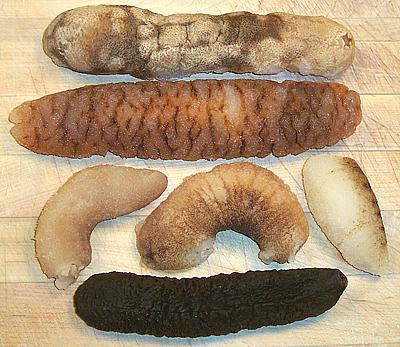 [Bêche-de-mer, order Holothuroidea]
[Bêche-de-mer, order Holothuroidea]
Sea cucumbers are known from the Silurian 400 million years ago, but may be even more ancient. Today they live in every marine environment from tidal to the deepest trenches, but not in fresh water or on land. They should not be called "sea slugs" because they are not mollusks.
Most sea cucumbers are less than 12 inches long, but there is one that can grow to more than 7 feet. They are of pharmaceutical interest (interesting toxins, mostly) and are a popular food item in Asia. They are exported to China from all over the Indo-Pacific region and have been badly over-fished in some areas, particularly the Pacific islands. This has resulted in development of large aquaculture operations in China, Japan, Australia and elsewhere.
The photo specimens were recruited from markets in San Gabriel, California that serve a mixed Chinese / Vietnamese community. The big ones were labeled "U.S.A wild grown" (probably from Alaska) but no provenance was given for the others. The largest was 9 inches and weighed 8.6 ounces. The black ones are firmest and have the most flavor.
More on Shellfish.
Sea Cucumber is firmly gelatinous and the flavor mild. Black ones have the most flavor and are my favorite, followed by red ones. The flavor hints of iodine. Their main function in most recipes is textural and to absorb flavors.
Raw sea cucumber can be ordered in some of the better stocked sushi bars as Namako. It is somewhat crunchy raw, and I find it good that way.
The samples of frozen ones I have purchased appear to have had the digestive system pulled out but the ribbon-like "respiratory trees" left in. They have about the same flavor as the tube wall so are not a problem. Frozen sea cucumber should be thawed and washed under running water inside and out to remove sand and any internals that weren't removed in processing.